Welcome to another edition of Progressive Eats, our virtual version of a progressive dinner party. This month I get to be the hostess with the mostest and I chose Flavors of France for our theme. Our trip last fall left a lasting impression and I thought it would be fun to see how the other gals interpret their French favorites. I know you’ll love all the recipes – this is one creative bunch! Make sure you check out the links below the recipe.
When I was growing up, chicken was the poultry of choice for our family with turkey as our holiday treat. I had never tried duck … it always seemed so exotic to me. I finally got to try it when I was a young teenager.
Occasionally when my father was heading out for a business trip, he would bring mom and me along. My brothers were older and in college when these trips would come up, so I was the only kid still at home. There are some benefits to being the youngest.
It was my first trip to New York City and my dad was showing us the town. We were having dinner in the Rainbow Room at the top of Rockefeller Plaza with the lights of the city laid out below us like a carpet. I was enthralled and my dad had wrangled us a table next to the windows. I will never forget that view or how grown up I felt sitting in the elegant restaurant.
The menu was fascinating. Here was my chance to eat like a grown up, so I ordered the duck.
I thought it would taste like chicken (insert joke here) and was shocked when it arrived, a deep pink color with a slightly stronger flavor. It was a little too much to my unsophisticated palate, so I swapped plates with my dad, enjoying every bite of the steak he had ordered. It was many years later before I tried duck again and this time it was a totally different experience. I fell in love.
The duck we get today is usually farm raised and much less gamy that it used to be, so don’t be afraid to try it. It is now one of my favorite proteins and The Artist and I enjoy it several times a year.
Most poultry is delicious served with a fruit pan sauce, but I think duck is particularly suited to it, especially citrus flavors. The bright and slightly sour fruit helps cut through the richness of the duck, giving us a delectable sauce and one of the best of classic French dishes.
The real trick to the dish is to render the fat on the breast, crisping the skin perfectly without overcooking the meat. Duck should always be served medium-rare for the tenderest bite. The mistake most people make is overcooking it and they wind up with a tough bird that is barely palatable.
If you are trying to cook an entire duck, you will undoubtedly over cook the breast while you are waiting for the legs to render all their fat. The best solution is the cook the breasts and legs separately, starting with the legs to give them the extra time they need and kick start the rendering. Then you can add the breasts to the same pan and by the time they are done, the legs should be ready too.
I hope you love this dish as much as I do. It is perfect for special occasions or holidays ~ Christmas, New Year’s Eve and Valentine’s Day would all be wonderful times to serve this. Perhaps it will start a tradition of hosting an elegant French-themed dinner every year. The links below will give you many ideas on ways to fill out your menu and thrill your family and friends.
Bon Appetit!
Jane’s Tips and Hints:
The recipe calls for fresh oranges to be cut into segments. If oranges aren’t at their peak, or you don’t have time to cut the segments out, you can use canned mandarin oranges. It is a quick and easy substitute. Not as delicious as fresh fruit, but a decent alternative that will save you time.
Gluten-Free Tips:
This dish is naturally gluten-free!!
Kitchen Skill: How to Segment an Orange
The segments of oranges are covered with a connective membrane that is edible but can be a little tough. The cut orange segments are called supremes (soo-prehms). It is easy to do but may be a little time intimidating the first time you do it. Don’t rush. With practice it gets easier.
Using a small sharp knife, slice of the top and bottom off each orange, deep enough to expose some of the flesh. Set the orange on one flat end. Working from the top to the bottom and using a sawing motion, slice away a portion of the peel, following the curve of the orange. Cut deep enough to remove all the white but don’t cut too much of the orange flesh. Repeat, moving around the orange for each cut. Go back and trim off any remaining white pith.
Now holding one orange in the palm of your hand, and working over a clean bowl, carefully slice right next to one of the white membranes. Then move your knife to the opposite side of that segment and make another cut releasing the segment. Slice down on the far side of the second membrane and again on the other side of that segment, releasing another segment. Keep working until all the segments have been removed from the membrane. Then squeeze the remaining juice from the membrane and throw the solid portion away. Repeat with the remaining oranges.
Here is a video from Fine Cooking that does a very good job of demonstrating this technique and when you’ve seen it done, it will be easy to replicate. The oranges can be prepared up to 6 hours ahead. Store, covered, in a bowl in the refrigerator with the juice you squeezed from the membrane.
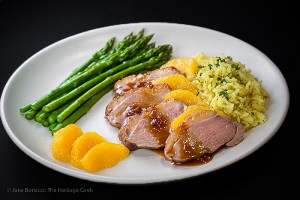

- Sauce
- 1 tbsp grated orange zest
- 4 large naval oranges
- 1/4 cup granulated sugar
- 2 tablespoons water
- 2 tbsp dry vermouth
- 1 tbsp apple cider vinegar
- 1-1/3 cups fresh orange juice (preferably one without added sugar)
- 2 large shallots, peeled and finely minced
- 1-1/2 cups low-salt chicken broth
- Duck
- 2 lb boneless duck breasts
- 2 tbsp butter
- 2 tbsp duck fat (from rendering and crisping the skin)
- Freshly chopped parsley or Gourmet Garden's Lightly Dried Parsley, for garnish
- Make the Sauce: Grate the oranges before cutting, removing only the orange portion and not any of the bitter white pith. Place the zest in a small bowl, cover and set aside while you make the rest of the sauce. Segment the fruit (see Kitchen Skill above) over a bowl and place the segments in the bowl with the accumulated juices.
- In a heavy 4-quart saucepan (preferably with a light interior), combine the sugar and water together. Cook over medium heat, stirring until the sugar is dissolved. Stop stirring, raise the heat to medium-high and bring to a full boil. Place a lid on the pan and let the steam wash down the sides of the pan for about 2 minutes. Remove the lid and cook the sugar mixture until it caramelizes and becomes deep golden brown, about 8 to 10 minutes.
- Remove the pan from the heat, and standing back, add the vermouth and vinegar. The mixture will bubble up furiously so be careful not to get splashed with the scalding sugar. Stir the mixture then add the orange juice and shallots. Bring back to a boil and cook over medium heat (holding a low boil) until reduced to about 1/2 cup, stirring occasionally. It will take about 15 minutes. Stir in the chicken broth, bring back to a boil, reduce the heat to medium - medium-low and cook until reduced to about 1 cup, about 30 minutes later. Remove from the heat and set on the back of the stove and keep warm over very low heat stirring occasionally.
- The sauce and segmented oranges can be prepared up to 6 hours in advance.
- Prepare the Duck: Using a sharp knife, make a series of parallel slices on the diagonal through the fat cap of each breast, being careful not to cut into the meat below. Repeat, making slices in the opposite direction to create a diamond pattern. Season both sides of the breasts with salt and pepper.
- Heat a 12-inch heavy skillet over medium-high heat. When the pan is hot, place the breasts skin-side down and lower the heat to medium. Cook the breasts without moving until the release easily from the bottom of the pan and are deeply golden brown and crispy. This can take 10 to 15 minutes depending on the strength of the stove. Use tongs and flip the breasts over to cook the second side. Cook for about 3 to 4 minutes or until done to your liking. Duck is most tender and delicious when cooked medium-rare. Anything above that and the meat becomes tough. When done, transfer to a clean cutting board, loosely tent with foil and let rest for about 10 minutes.
- While the duck is resting, remove all but 2 tbsp of the duck fat from the skillet. Be sure to save this because it is delicious for so many other dishes! You can store it in the freezer if you won’t use it right away.
- Add the butter to the remaining duck fat in the skillet and melt. Then pour in the sauce you made earlier and add the grated orange zest.
- Slice duck breasts crosswise on the diagonal, holding your carving knife at about a 45° angle. Arrange the slices on 4 plates, fanning them into a decorative pattern. Spoon some of the sauce over the sliced duck, add a few of the orange segments as garnish and sprinkle a little of the parsley on each serving.
- Add the remaining orange segments to the rest of the sauce, stirring them together. This sauce can be passed at the table for your guests to add more if they want, or keep covered in the refrigerator up to a few days.
- The sauce is also wonderful served with chicken or pork.
Create a New Tradition Today!
This recipe is part of our monthly progressive dinner party called Progressive Eats. See the links below for more inspiration and great recipes!
Join us for the Flavors of France!
Appetizers
- Tarte á l’Oignon – French Onion Tart from Spice Roots
- Gougeres filled with Bechamel aux Champignons from Pastry Chef Online
Salad
- French Carrot Salad from Stetted
- Salade de Tomates et Fromage from That Skinny Chick Can Bake
Soups
- Provencal Vegetable Soup Au Pistou from Mother Would Know
Main Course
- Duck Breasts a l’Orange from The Heritage Cook
Bread
- Fig and Anise Bread from The Wimpy Vegetarian
Veggies/Sides
- Zucchini Summer Squash Tomato Gratin from Jeanette’s Healthy Living
Drinks
- Kir Royale from Miss in the Kitchen
Desserts
- Lemon Glazed Madeleines from Barbara Bakes
- Triple-Layer Chocolate Macaroon Cake from François Payard from Creative Culinary
If you’re unfamiliar with the concept of a progressive dinner party, a group of friends travel from house to house, enjoying a different course at each location. With Progressive Eats, a theme is chosen each month, members share recipes suitable for a delicious meal or party, and you can hop from blog to blog to check them out. To see our upcoming themes and how you can participate, please check out the schedule at Creative Culinary or contact Barb for more information. We have a core group of 12 bloggers, but we will always need substitutes and if there is enough interest, would consider additional groups.
Unauthorized use, distribution, and/or duplication of proprietary material from The Heritage Cook without prior approval is prohibited. This includes copying and reprinting content and photographs. If you have any questions or would like permission, I can be contacted via email. Feel free to quote me, just give credit where credit is due, link to the recipe, and please send people to my website, www.theheritagecook.com. Please see the Disclaimers page for additional details.
This site is not intended to provide medical advice. The suggestions here are not intended as dietary advice or as a substitute for consulting a dietician, physician, or other medical professional. It is the reader’s sole responsibility to determine which foods are appropriate and safe for their family to consume. Always consult your doctor. The author makes no claims regarding the presence of food allergens and disclaims all liability in connection with the use of this site.
Thank You!
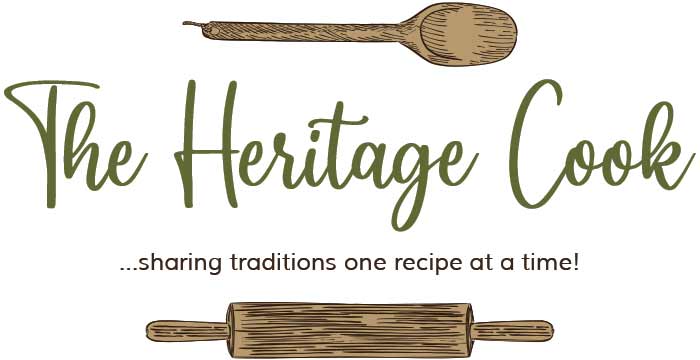
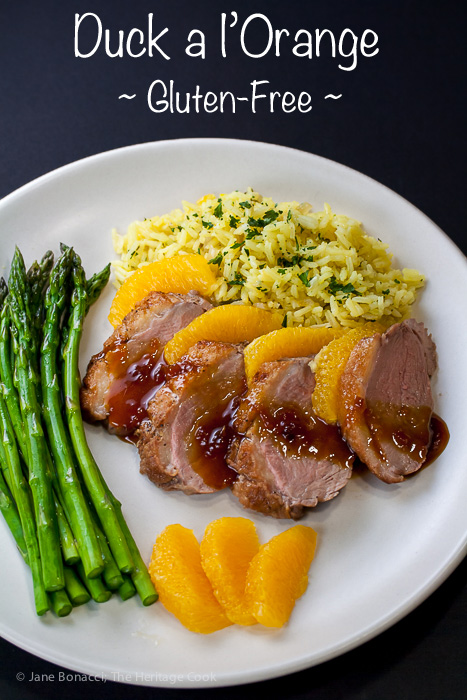
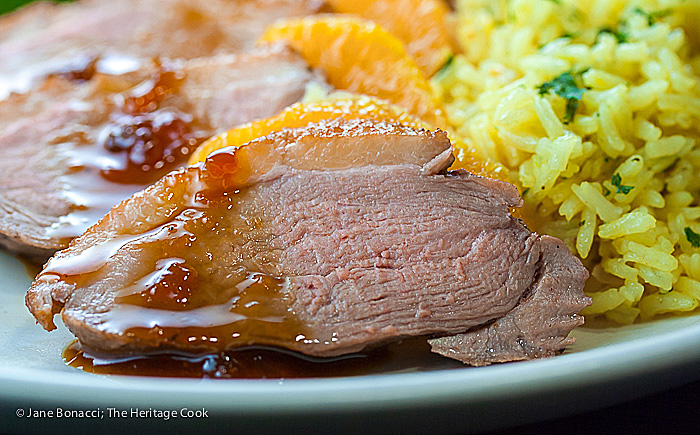
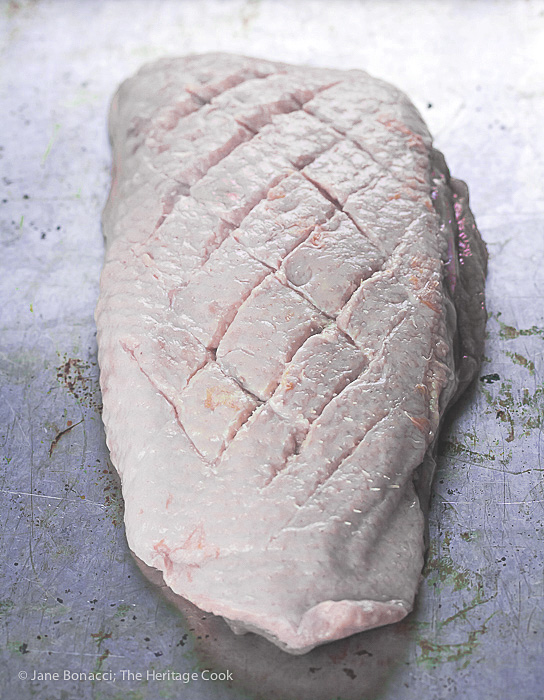
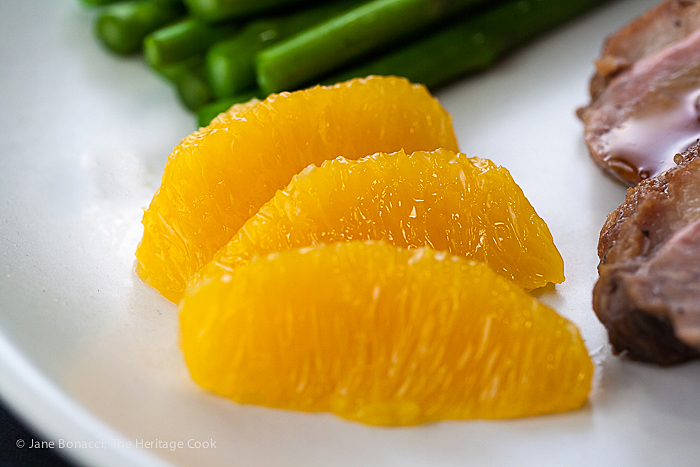
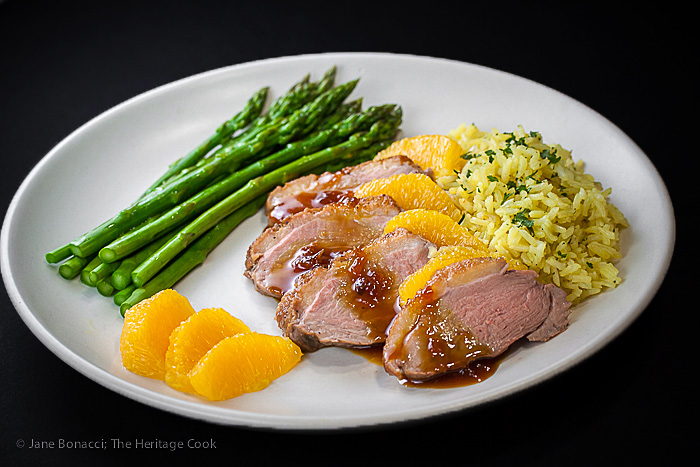

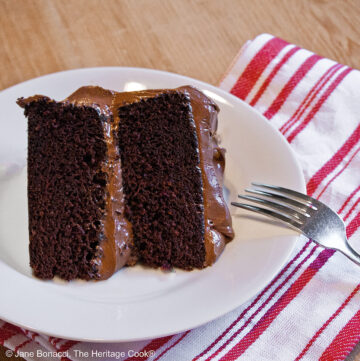
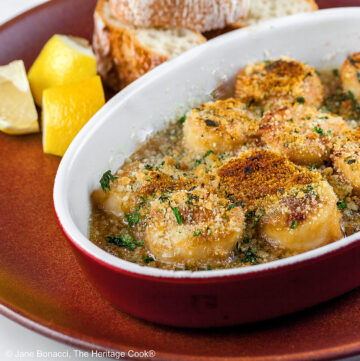
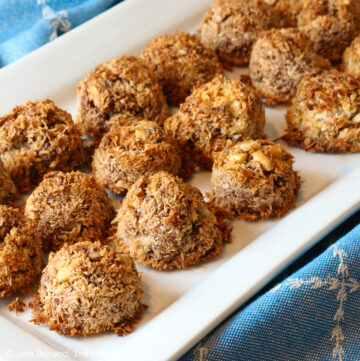
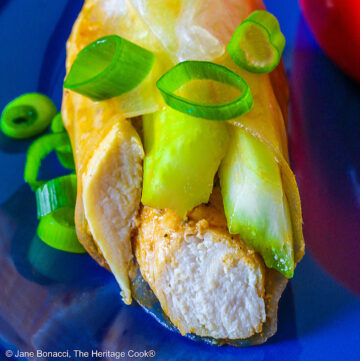
Barbara @ Barbara Bakes
Great tips! I’ve never cooked duck before. I need to change that.
Jane Bonacci
Oh I hope you do Barbara, it is so lovely. You can also grill or roast duck, it is very versatile. And it will go perfectly with your stunning lemon madeleines … Enjoy!
Ansh
My teen daughter switches plates with my husband when she doesn’t like what she ordered. That story with your Dad made me laugh and say, I know how that works. I grew up eating duck and LOVE it. Ans I have a feeling this might become a favorite dish soon at our house.
Exceptionally beautiful – the dish, and the plating and the Event!! Thank you for the theme! I LOVED IT.
Jane Bonacci
Glad that you appreciated the irony of swapping plates with my dad. 😉 I loved that you chose to really push your comfort zone this month Anshie – and you nailed it! Your tart is stunning and I can’t wait to see all the pastries you will be making from here on out! Brava!! 🙂
Jeanette | Jeanette's Healthy Living
What a gorgeous dish Jane – I love that childhood memory with your dad, so special. Beautiful plating too! Thanks so much for hosting our progressive dinner this month!
Jane Bonacci
Thank you Jeanette, it was such a fun theme with so many directions people could take! I had the image for the plating in my head before I even started cooking … the first time that has happened! 🙂
Laura @MotherWouldKnow
You’ve come a long way baby! (Remember where that phrase is from?) I loved your story and can well imagine your dad smiling inside as he traded plates. Should I admit so publicly, that although I love duck and especially duck with citrus sauce, I’ve never made it. But I’m feeling empowered with your incredible instructions and tips, so maybe this is the year my duck a l’orange will be prepared in my own kitchen.
Jane Bonacci
Ah Laura, I know that phrase all too well, LOL. I hope you give this a try, keeping to just the breasts, it is much easier to make successfully. And once you’ve mastered this, you can conquer the world 🙂
Jenni
Wow–a table by the window. Well done, Dad! Your duck is just beautiful. And I love how the sauce is built on caramel. Wonderful! Thanks so much for choosing this great theme, Jane!
Jane Bonacci
It was amazing to watch the sauce come together Jenni ~ the traditional caramel suddenly transformed into a savory citrus sauce! And man the house smelled amazing! 🙂
Liz
What fun memories of your dad and of your first experience with duck. My hubby is a huge fan and would be thrilled if I made him your classic dish! Thanks so much for hosting us today, Jane!
Jane Bonacci
I’m so happy everyone had fun with the French theme today and I hope you do make this for your husband. I’ll be you get a round of applause, LOL!